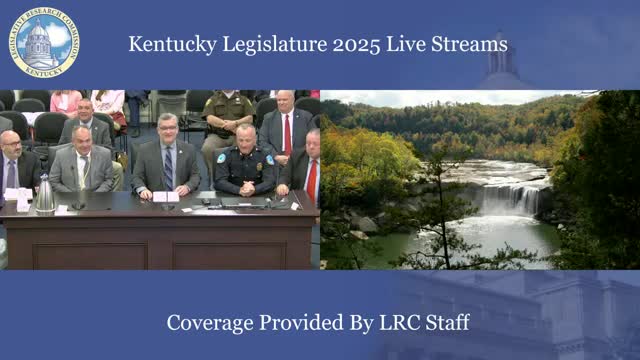Kentucky committee advances bill to increase fixed-dollar CERS retiree health subsidies
February 19, 2025 | 2025 Legislature KY, Kentucky
This article was created by AI summarizing key points discussed. AI makes mistakes, so for full details and context, please refer to the video of the full meeting. Please report any errors so we can fix them. Report an error »

Senator Mills, sponsor of Senate Bill 10, told the Senate State and Local Government Committee that the legislation would change retiree health benefits under the County Employees Retirement System (CERS) for members who began participating on or before July 1, 2003. "This legislation will change CERS retiree health benefits available for members who began participating in the system on or before 07/01/2003," Senator Mills said.
The bill would raise the fixed dollar health subsidy for nonhazardous CERS retirees who retire after 27 years of service from $14.63 per month for each year of service to $40 per month per year of service. For hazardous-duty retirees retiring after 20 years in tier 1 or 25 years in tier 2 and tier 3, the subsidy would increase from $21.94 per month per year of service to $50 per month per year of service. "The goal of these changes is to allow the retiree to be able to pay the cost of a single premium, which we believe is very consistent with what was set in 02/2003 when they created a fixed dollar health subsidy," Senator Mills said.
Supporters representing public safety organizations told the committee the change would aid recruitment and retention. Jerry Wagner, retired sheriff and director of the Kentucky Sheriffs Association, said the change would "fix" hiring and retention problems and help agencies rehire retirees for security roles. Jeremy Thompson, chief of police in Elizabethtown and representative of the Kentucky Chiefs Association, said the increase "allows them, a better, ability to afford insurance for them, for their families when they retire." Jeff Taylor, director of legislative affairs for the Kentucky Professional Firefighters, said the stipend would influence his personal retirement timing and called the measure a "huge" retention incentive.
Under the bill, employees would share in the cost. Nonhazardous employees on the health subsidy hired before Sept. 1, 2008, would begin contributing an additional 1 percentage point (to match tier 2 and tier 3 rates). Hazardous employees would increase contributions by 1 percentage point (from 1% to 2%). Senator Mills cited actuarial estimates presented to the committee: because the nonhazardous health fund is about 22.3% funded, the analysis does not anticipate an immediate employer contribution increase; the hazardous fund—described in the hearing as about 0.5% funded—would likely see a modest employer contribution increase, estimated around 2.2% if the benefit is adopted as proposed.
Committee members praised the collaborative negotiation among employers, employee groups and the Public Protection Oversight Board (PPOB). Several senators used their explanation-of-vote time to thank first responders and emphasize the bill's role in workforce stability. The committee recorded a favorable vote, and the measure will be sent to the Senate floor for further consideration.
The committee record and testimony identified the subsidy changes, the employee-contribution increases, and the actuarial funding assumptions as the principal elements for implementation. No formal amendments or alternative funding offsets were recorded in the committee proceeding.
The bill would raise the fixed dollar health subsidy for nonhazardous CERS retirees who retire after 27 years of service from $14.63 per month for each year of service to $40 per month per year of service. For hazardous-duty retirees retiring after 20 years in tier 1 or 25 years in tier 2 and tier 3, the subsidy would increase from $21.94 per month per year of service to $50 per month per year of service. "The goal of these changes is to allow the retiree to be able to pay the cost of a single premium, which we believe is very consistent with what was set in 02/2003 when they created a fixed dollar health subsidy," Senator Mills said.
Supporters representing public safety organizations told the committee the change would aid recruitment and retention. Jerry Wagner, retired sheriff and director of the Kentucky Sheriffs Association, said the change would "fix" hiring and retention problems and help agencies rehire retirees for security roles. Jeremy Thompson, chief of police in Elizabethtown and representative of the Kentucky Chiefs Association, said the increase "allows them, a better, ability to afford insurance for them, for their families when they retire." Jeff Taylor, director of legislative affairs for the Kentucky Professional Firefighters, said the stipend would influence his personal retirement timing and called the measure a "huge" retention incentive.
Under the bill, employees would share in the cost. Nonhazardous employees on the health subsidy hired before Sept. 1, 2008, would begin contributing an additional 1 percentage point (to match tier 2 and tier 3 rates). Hazardous employees would increase contributions by 1 percentage point (from 1% to 2%). Senator Mills cited actuarial estimates presented to the committee: because the nonhazardous health fund is about 22.3% funded, the analysis does not anticipate an immediate employer contribution increase; the hazardous fund—described in the hearing as about 0.5% funded—would likely see a modest employer contribution increase, estimated around 2.2% if the benefit is adopted as proposed.
Committee members praised the collaborative negotiation among employers, employee groups and the Public Protection Oversight Board (PPOB). Several senators used their explanation-of-vote time to thank first responders and emphasize the bill's role in workforce stability. The committee recorded a favorable vote, and the measure will be sent to the Senate floor for further consideration.
The committee record and testimony identified the subsidy changes, the employee-contribution increases, and the actuarial funding assumptions as the principal elements for implementation. No formal amendments or alternative funding offsets were recorded in the committee proceeding.
View full meeting
This article is based on a recent meeting—watch the full video and explore the complete transcript for deeper insights into the discussion.
View full meeting
